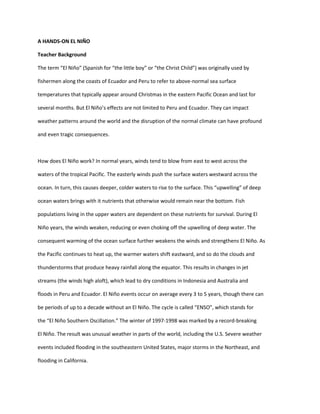
El-Nino-and-La-Nina-Activity.docx
- 1. A HANDS-ON EL NIÑO Teacher Background The term “El Niño” (Spanish for “the little boy” or “the Christ Child”) was originally used by fishermen along the coasts of Ecuador and Peru to refer to above-normal sea surface temperatures that typically appear around Christmas in the eastern Pacific Ocean and last for several months. But El Niño’s effects are not limited to Peru and Ecuador. They can impact weather patterns around the world and the disruption of the normal climate can have profound and even tragic consequences. How does El Niño work? In normal years, winds tend to blow from east to west across the waters of the tropical Pacific. The easterly winds push the surface waters westward across the ocean. In turn, this causes deeper, colder waters to rise to the surface. This “upwelling” of deep ocean waters brings with it nutrients that otherwise would remain near the bottom. Fish populations living in the upper waters are dependent on these nutrients for survival. During El Niño years, the winds weaken, reducing or even choking off the upwelling of deep water. The consequent warming of the ocean surface further weakens the winds and strengthens El Niño. As the Pacific continues to heat up, the warmer waters shift eastward, and so do the clouds and thunderstorms that produce heavy rainfall along the equator. This results in changes in jet streams (the winds high aloft), which lead to dry conditions in Indonesia and Australia and floods in Peru and Ecuador. El Niño events occur on average every 3 to 5 years, though there can be periods of up to a decade without an El Niño. The cycle is called “ENSO”, which stands for the “El Niño Southern Oscillation.” The winter of 1997-1998 was marked by a record-breaking El Niño. The result was unusual weather in parts of the world, including the U.S. Severe weather events included flooding in the southeastern United States, major storms in the Northeast, and flooding in California.
- 2. El Niño’s twin sister is “La Niña” (“the little girl” in Spanish). Her effects are, as any siblings would expect, the exact opposite of El Niño’s: for instance, precipitation is below normal in California and the southeastern U.S. La Niña is characterized by below normal sea surface temperatures in the eastern equatorial Pacific. There are large variations in weather for many U.S. locations from warm spells to cold waves during a La Niña winter. (Adapted, with permission, from the EPA/NASA/NOAA Climate Change Presentation Kit CDROM.) Objectives Students will make simulate ocean currents and cold water upwelling typical of El Niño. Students will research connections between El Niño and global and local weather and climate. Vocabulary El Niño ENSO La Niña Upwelling Materials (for each team of students) glass baking dish or clear plastic shoebox cooking oil food coloring (green seems to work best) bendable straw apron goggles Engage Ask students what the terms El Niño and La Niña mean. Discuss weather conditions you are currently experiencing due to an El Niño or La Niña. Explain/Explore
- 3. To minimize the chance for flying ocean water (which made one teacher-reviewer note he’d not try this Activity with his current set of students!) this is suggested as a teacher supervised, student implemented Activity rather than as something for students to undertake independently.) Accordingly there is no Student Worksheet and the procedure appears only here in the Guide. Procedure Guide students through the implementation of this Activity. 1. Fill the baking dish or shoebox about 3/4 full with water. 2. Place a few drops of food coloring in the water and let it mix thoroughly. 3. Very slowly pour cooking oil on top of the water until there is the thinnest coating possible on top of the water. The entire surface of the water should be covered. 4. Place the long end of the straw (the end furthest away from the bend) in your mouth and gently blow across the top of the oil. There should be some visible movement, but not enough to spray the oil out of the pan. 5. Stop blowing and record your observations. (Students should notice a hole in the layer of oil which quickly closes up when you stop blowing. The hole is easier to observe after you stop blowing.) Describe the circulation pattern of the oil. Compare your model to what happens in the Pacific Ocean during an El Niño. Compare your model to what happens during a La Niña. Expand/Adapt/Connect Experiment with different depths of water and oil and different wind speeds. Does the warm pool creep back over the surface if the winds only blow for a short while? Research the effect El Niño and La Niña have on the climate of your area. Suggested URLs http://www.coe.usouthal.edu/oar/html/ocean_currents.html NOAA OAR web page for students on ocean currents: good background, activities and links to
- 4. additional resources. http://www.pmel.noaa.gov/toga-tao/el-nino/nino-home.html NOAA’s El Niño Theme Page: background information, including current ENSO status. http://www.dir.ucar.edu/esig/la_nina_home/ La Niña Home page, explaining the human impact, forecasts and links to additional resources. http://airsea-www.jpl.nasa.gov/ENSO/welcome.html El Niño from NASA’s satellite resources: the oceanographic, meteorological and biological viewpoint, plus animations and links. © PASSPORT TO KNOWLEDGE, 2000